- 814 views
- 0 comments
.png)
Are you curious about the differences between lab-grown and natural diamonds? Well, you've come to the right place. In this blog post, we'll be diving into the world of diamonds and exploring the pros and cons of each type. With advancements in technology, lab-grown diamonds have become a popular alternative to natural diamonds. But what sets them apart? Join us as we uncover the truth about lab-grown vs. natural diamonds and help you make an informed decision for your next diamond purchase.
THE FORMATION PROCESS OF NATURAL DIAMONDS
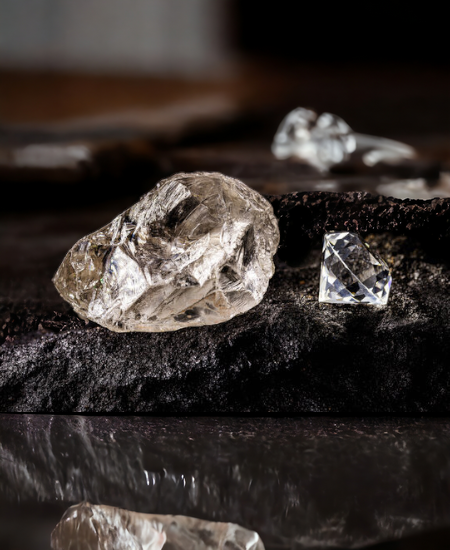 Natural diamonds are formed deep within the Earth's mantle under intense pressure and heat. It all begins with carbon atoms, which are found in abundance within the Earth's crust. Over millions of years, these carbon atoms have been subjected to immense pressure, often caused by tectonic plate movement, and extreme temperatures of over 2,200 degrees Fahrenheit. Under these extreme conditions, the carbon atoms bond together in a crystalline structure, forming diamonds.
Natural diamonds are formed deep within the Earth's mantle under intense pressure and heat. It all begins with carbon atoms, which are found in abundance within the Earth's crust. Over millions of years, these carbon atoms have been subjected to immense pressure, often caused by tectonic plate movement, and extreme temperatures of over 2,200 degrees Fahrenheit. Under these extreme conditions, the carbon atoms bond together in a crystalline structure, forming diamonds.
The diamonds then slowly make their way towards the Earth's surface through volcanic eruptions. These eruptions, called kimberlite eruptions, carry the diamonds to the surface, where they are eventually discovered. The formation process of natural diamonds is a rare and remarkable phenomenon that takes millions of years to occur. Each diamond is unique, with its distinct characteristics, including color, clarity, and cut.
THE CREATION OF LAB-GROWN DIAMONDS
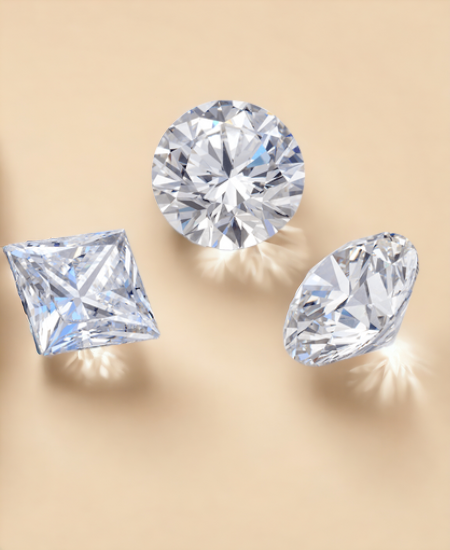 Lab-grown diamonds, also known as man-made or lab-created diamonds are created in a laboratory instead of being formed naturally in the Earth's crust. The process of creating lab-grown diamonds involves using advanced technology to replicate the same conditions that occur deep within the Earth.
Lab-grown diamonds, also known as man-made or lab-created diamonds are created in a laboratory instead of being formed naturally in the Earth's crust. The process of creating lab-grown diamonds involves using advanced technology to replicate the same conditions that occur deep within the Earth.
To start, a tiny diamond seed is placed in a growth chamber, which is then filled with a mixture of carbon and other elements. Through a combination of extreme heat and pressure, the carbon atoms begin to bond together and form a crystalline structure, just like natural diamonds. This process takes several weeks to months, depending on the desired size of the diamond. The result is a lab-grown diamond that is chemically and physically identical to a natural diamond. They have the same hardness, brilliance, and durability. However, some differences can be detected by trained gemologists.
THE PRICING DIFFERENCE
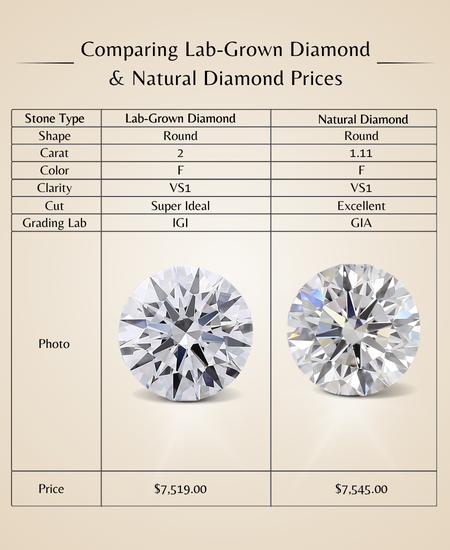 When it comes to buying a diamond, one of the key factors that many people consider is the price. The pricing difference between lab-grown and natural diamonds can be significant. Usually, diamonds made in a lab cost less than natural diamonds. This is because the process of creating lab-grown diamonds in a controlled environment is more cost-effective than mining and extracting natural diamonds from the Earth. The affordability of lab-grown diamonds is one of the main advantages they have over natural diamonds. For those who are looking for a beautiful diamond at a more affordable price, lab-grown diamonds are a great option. They offer the same quality and characteristics as natural diamonds but without the hefty price tag.
When it comes to buying a diamond, one of the key factors that many people consider is the price. The pricing difference between lab-grown and natural diamonds can be significant. Usually, diamonds made in a lab cost less than natural diamonds. This is because the process of creating lab-grown diamonds in a controlled environment is more cost-effective than mining and extracting natural diamonds from the Earth. The affordability of lab-grown diamonds is one of the main advantages they have over natural diamonds. For those who are looking for a beautiful diamond at a more affordable price, lab-grown diamonds are a great option. They offer the same quality and characteristics as natural diamonds but without the hefty price tag.
On the other hand, natural diamonds are generally more expensive due to their rarity and the labor-intensive process involved in mining them. The supply of natural diamonds is limited, which drives up their price. Additionally, the mining process can be environmentally and ethically concerning, contributing to the higher cost of natural diamonds. Ultimately, the pricing difference between lab-grown and natural diamonds allows consumers to choose based on their budget and priorities.
THE ENVIRONMENTAL AND ETHICAL FACTORS
When it comes to diamonds, the environmental and ethical factors play a significant role in decision-making. Natural diamond mining can have a detrimental impact on the environment. The process involves clearing land, displacing wildlife, and releasing harmful chemicals into the air and water. Additionally, the diamond industry has faced scrutiny for its labor practices, including reports of forced labor and poor working conditions in some mining areas.
On the other hand, lab-grown diamonds offer a more sustainable and ethical alternative. Since they are created in a controlled laboratory environment, there is no need for mining or land disruption. Lab-grown diamonds also have a smaller carbon footprint compared to their natural counterparts, as they require less energy and water to produce.
In terms of ethics, lab-grown diamonds are considered conflict-free. Natural diamonds, on the other hand, have a history of being associated with conflict or "blood diamonds," which are mined in war zones and used to fund armed conflicts. It's crucial to make an informed decision and choose a diamond that aligns with your values.
DECIDING WHICH DIAMOND IS BEST FOR YOU
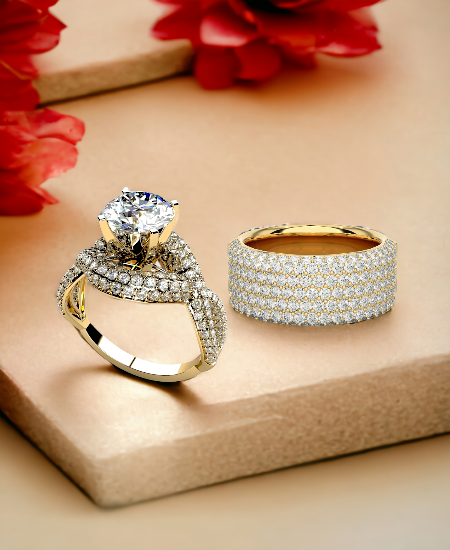 Deciding which diamond is best for you can be a challenging decision, but it ultimately comes down to your personal preferences and priorities. If you value the natural beauty and uniqueness that comes with a natural diamond, then it may be the right choice for you. Natural diamonds have a timeless appeal and a long history of being treasured as precious gems. They often have a higher market value and are considered a symbol of luxury and prestige.
Deciding which diamond is best for you can be a challenging decision, but it ultimately comes down to your personal preferences and priorities. If you value the natural beauty and uniqueness that comes with a natural diamond, then it may be the right choice for you. Natural diamonds have a timeless appeal and a long history of being treasured as precious gems. They often have a higher market value and are considered a symbol of luxury and prestige.
On the other hand, if you prioritize sustainability, ethical sourcing, and a smaller environmental footprint, then a lab-grown diamond might be the better option. Lab-grown diamonds offer the same physical and chemical properties as natural diamonds but without the ethical concerns associated with mining. They are created in a controlled environment using advanced technology, making them a more eco-friendly choice.
Consider your budget as well. Natural diamonds tend to be more expensive due to their rarity, while lab-grown diamonds can offer a more affordable alternative without sacrificing quality.
In the end, choosing between natural and lab-made diamonds depends on what's important to you. Spend some time learning about each type, compare them, and decide what you like the most. No matter if you pick a real or lab-made diamond, the key is to find one that suits your beliefs and makes you feel good.
PICK THE PERFECT RING FROM OUR COLLECTIONS
FAQ
1. Can the average person spot the difference?
In most cases, it is difficult for the average person to spot the difference between a natural and a lab-grown diamond with the naked eye. Both types of diamonds have the same physical and chemical properties, which mean they sparkle and shine similarly. However, trained gemologists can identify the differences using specialized equipment.
2. What kind of diamond should I choose?
The choice between a natural and a lab-grown diamond ultimately depends on your personal preferences and priorities. If you value the uniqueness and natural beauty that comes with a natural diamond, then it may be the right choice for you. On the other hand, if you prioritize sustainability, ethical sourcing, and a smaller environmental footprint, then a lab-grown diamond might be the better option.
3. Which is better, lab or natural diamonds?
There is no definitive answer to this question. It depends on what you value most. Natural diamonds have a timeless appeal and are often seen as a symbol of luxury and prestige. On the other hand, diamonds grown in labs provide a more environmentally-friendly and fair option. They are created in a controlled laboratory environment, minimizing harm to the environment and ensuring ethical sourcing.
4. Do lab-grown diamonds have the same durability as natural diamonds?
Yes, lab-grown diamonds have the same durability as natural diamonds. They are both composed of carbon and have the same hardness rating of 10 on the Mohs scale. This means they are extremely resistant to scratching and can withstand everyday wear and tear.
5. Do lab-grown diamonds cost less than natural diamonds?
Generally, diamonds grown in labs are typically more affordable than those naturally formed. This is because natural diamonds are rare and require significant resources to mine, which drives up their price. Lab-grown diamonds, on the other hand, can be produced more efficiently in a laboratory, making them a more cost-effective option.
Remember, when deciding between natural and lab-grown diamonds, it's important to consider your values and priorities. Whether you choose a natural or lab-grown diamond, what matters most is finding a diamond that aligns with your values and makes you feel confident and happy.
In search of diamond rings to grace your hand or surprise a special someone? At Mudrika.com, your quest is finally over. Embark on a journey through our vast and intricate collection offering not only naturally crafted but also lab-grown diamond rings. No matter the depth of your pocket, we have an ideal masterpiece tailored just for your exclusive taste. Make a pick of a diamond that mirrors your convictions and bask in the delight and self-assurance that comes with wearing it. Discover, explore, and cherish our timeless pieces that are set to match every inch of your style. Your dream ring waits at Mudrika.com, the final stop in your quest for that perfect diamond ring.
SHOP EXPERTLY CRAFTED RINGS
Read More
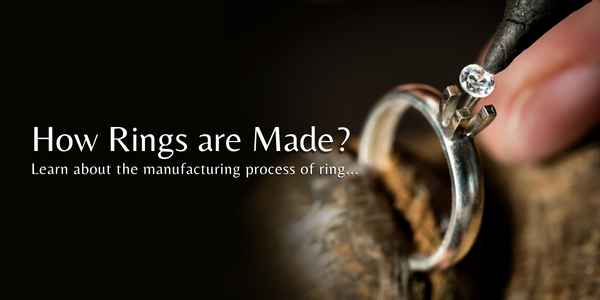
HOW RINGS ARE MADE?
Ever wondered how rings are made? Look no further! In this blog, we will take you on a journey through the step-by-step manufacturing process of rings. From the initial design to the final polishing, you will learn about the careful craftsmanship and attention to detail that goes into every ring. With our expert techniques and high-quality materials, we guarantee that our rings are not only stunning but also durable and long-lasting. So why settle for a mass-produced, generic ring when you can have one that is uniquely crafted just for you? Keep reading to discover the magic behind how rings are made and be ready to be amazed!
Read more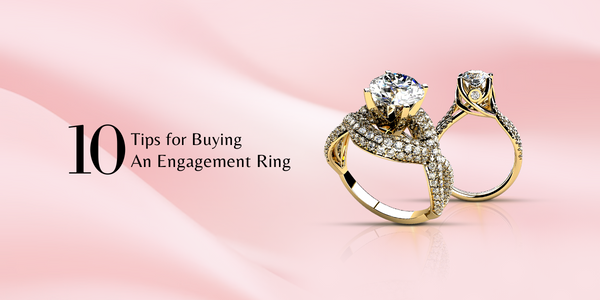
10 TIPS FOR BUYING AN ENGAGEMENT RING
Buying an engagement ring can be a daunting task, but don't worry, we've got you covered. In this blog, we'll be sharing our top 10 tips for buying an engagement ring that will help you make the perfect choice for your partner. From budgeting to finding the perfect style, we'll cover everything you need to know to make this special purchase a memorable one. So, let's dive in and get you one step closer to happily ever after!
Read more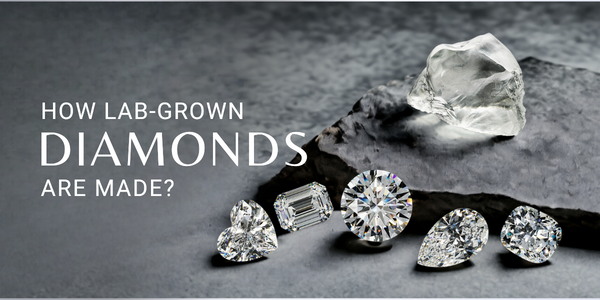
HOW LAB-GROWN DIAMONDS ARE MADE?
Have you ever heard about lab-grown diamonds? They shine, glitter, and enchant just like real diamonds, with the same physical and chemical properties. But unlike the gems mined from Earth's depths, these are made in labs. Dive in as we take you behind the scenes of how these mesmerizing lab-created diamonds are made.
Read more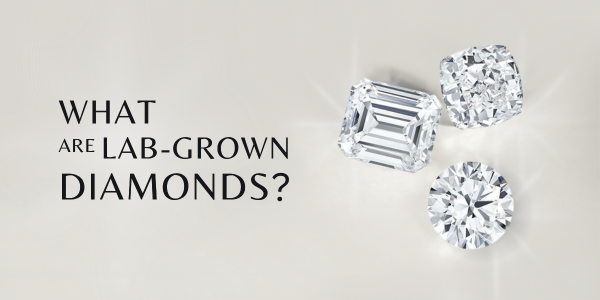
WHAT ARE LAB-GROWN DIAMONDS?
Hey there! Have you ever heard of lab-grown diamonds? If not, don't worry, you're not alone. These man-made diamonds have been gaining popularity in the jewelry industry in recent years. But what exactly are they and how do they differ from natural diamonds? Well, that's what we're here to talk about in this blog post. We'll break down the basics of lab-grown diamonds so you can become a diamond expert in no time. So, let's dive in and discover what makes these diamonds so unique and why they're becoming a popular choice for many.
Read more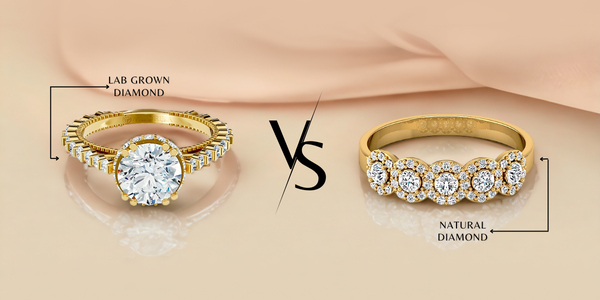
LAB GROWN VS NATURAL DIAMONDS
Hey there, diamond lovers! Are you curious about the differences between lab-grown and natural diamonds? Well, you've come to the right place. In this blog post, we'll be diving into the world of diamonds and exploring the pros and cons of each type. With advancements in technology, lab-grown diamonds have become a popular alternative to natural diamonds. But what sets them apart? Join us as we uncover the truth about lab-grown vs. natural diamonds and help you make an informed decision for your next diamond purchase.
Read more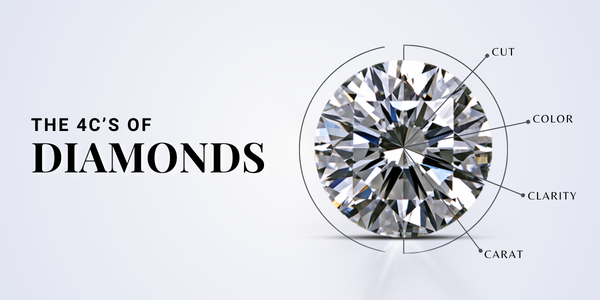
WHAT ARE THE 4CS OF DIAMONDS?
Hey there, diamond lovers! Have you ever heard of the 4cs of diamonds? If you're in the market for a diamond or just curious about the world of sparkling gemstones, then this blog post is for you. The 4cs are the universal standard for evaluating the quality and value of a diamond, and understanding them can help you make an informed decision when purchasing one. So, let's dive into the 4cs and discover what makes a diamond truly special and valuable. Get ready to be dazzled!
Read more
HOW TO MEASURE YOUR RING SIZE
Are you planning to buy a new ring but not sure about your ring size? Or have you ever received a ring as a gift that didn't fit your finger? Don't worry, you're not alone. Many people struggle with finding the perfect ring size, and it can be frustrating when the ring you love doesn't fit you properly. But the good news is that measuring your ring size is a simple process that you can do at home. In this blog post, we will guide you through the steps of how to measure your ring size accurately. So, let's get started and make sure your next ring fits you perfectly!
Read more
.png)
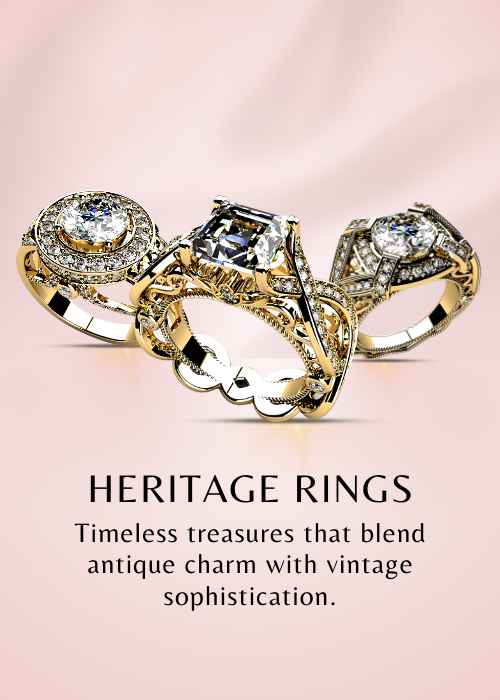
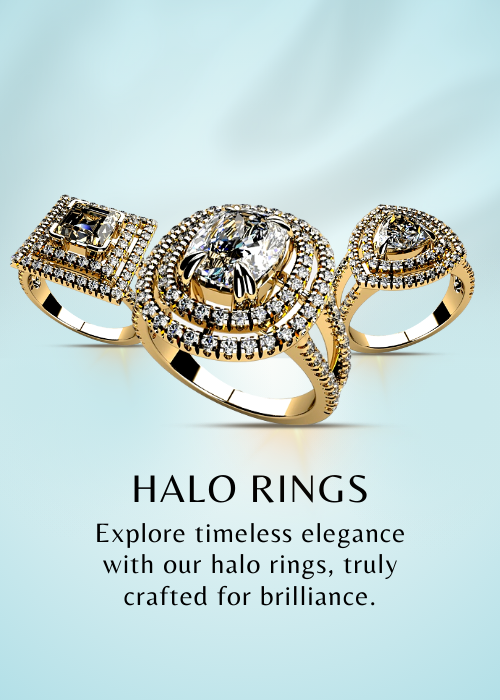









































Comments (0)